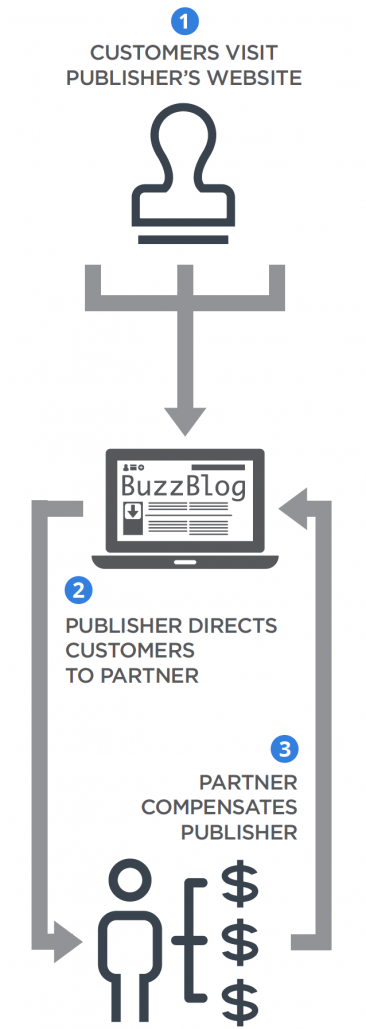
Photo by Rita Morais on Unsplash
Despite that echoing refrain that pops up year after year, affiliate marketing is far from dying. In fact, it’s thriving: affiliate marketing spend hit $5.4 billion in the U.S. in 2017, and is predicted to reach $8.2 billion by 2022. And the industry already generates 16% of all online orders — the same amount as email marketing. That makes affiliate marketing one of the top four biggest sources of e-commerce orders, beating out both display advertising and social commerce.
As members of the partner marketing ecosystem, affiliates are a valuable resource for brands looking to grow incrementally while maximizing ROI. (We would know; HasOffers, TUNE’s previous brand name, is the original software for affiliate networks, and we’ve been writing about the industry for years.)
Yet the cries of Affiliate marketing is dead! continue. That’s why we’re going back to the basics in this post to cover the what, who, and how of affiliate marketing — so you can make your own informed decision about the health of the industry.
Let’s get started.
What Is Affiliate Marketing?

Affiliate marketing in a nutshell.
Affiliate marketing is a type of performance marketing. It is one of many partnership-driven marketing strategies that exist under the umbrella of partner marketing.
In affiliate marketing, an individual (the affiliate) earns a commission for promoting an advertiser’s product. Commissions are usually based on the sales or revenue the affiliate generates for the advertiser; this is called revenue sharing. However, commissions can also be earned for leads or clicks, and be paid as a flat payout, tiered rate, set percentage plus a fixed amount, or a number of other ways.
You probably see affiliate marketing in action a dozen times a day. When a beauty blogger reviews a new makeup collection and links to it on her blog. When a “Bachelor in Paradise” star reveals the contents of their latest subscription box on Facebook, then encourages fans to purchase it with a unique promo code. When a website displays an ad in the sidebar for a camera, and the website publisher receives a commission for every purchase the ad drives.
Today, affiliate programs exist for almost every business and industry out there: big box stores, hotel chains, airlines, credit services, fashion, subscription economy boxes, home improvement, gaming, online retailers, gig economy apps, dating services, e-learning, real estate, cryptocurrency, health and wellness, sports, beauty brands, DTC retailers, SaaS companies, et cetera ad infinitum. Not surprising, given that 81% of brands were already leveraging affiliate marketing programs in 2016, and the industry’s only grown since.
Who Are the Main Players in Affiliate Marketing?
For those just getting started, it can be difficult to lock down exactly who is who and who does what in the affiliate marketing ecosystem. It doesn’t help that many terms in the industry are interchangeable or loosely defined. Before you begin to build an affiliate program, you should understand these key terms:
Affiliate Program
(also known as a partner program, affiliate marketing program, or partner marketing program)
A program offered by an advertiser that provides affiliate marketers a way to earn compensation in exchange for promoting a product or service. In an affiliate marketing program, affiliates are paid by the advertiser when a predetermined measurable action occurs. This action can be a purchase, form fill, registration, download, or other conversion.
Advertiser
(also known as a brand, marketer, merchant, or seller)
An owner of a product or service looking to pay affiliates to drive traffic to their website and/or app, with the goal of increasing revenue. In other words, someone with something to sell. Examples: a retailer looking to sell athletic shoes, a subscription box company looking for new subscribers, a real estate firm looking for new leads.
Affiliate
(also known as a publisher or partner)
A marketer who promotes advertiser products and services by driving traffic to their websites and/or apps through paid or non-paid channels. They generate revenue for the advertiser and earn a commission each time a predetermined measurable action occurs, such as a purchase or registration. An affiliate is the owner of a website, app, or other marketing channel where the advertisement can be promoted. Examples: personal blogs, Instagram profiles, podcasts, major news websites, gaming apps.
For example, if an advertiser wants to sell athletic shoes, they may choose to partner with several affiliates who run sports blogs. These affiliates have gathered audiences who align well with the advertiser’s target market. The advertiser provides a tracking link, which records each unique affiliate and the traffic they drive to the shoe website. The beautiful part about affiliate marketing is that everything is transparent and performance-based, so the advertiser only pays when a sale occurs.
Customer
(also known as a consumer, user, visitor, or traffic)
No surprises here; the customer is you and me — the ones buying the products being sold by advertisers and promoted by affiliates. In technical terms, traffic can be considered the actions that are measurable against an ad. Impressions (ad view), clicks (ad click), and conversions (ad engagement) are the most common.
In our example, the customer would click the tracking link in the athletic shoe promotion on the affiliate’s sports blog. If they ultimately purchase the shoes, the advertiser pays the affiliate a commission.
Affiliate Tracking Software
(also known as a performance marketing platform, partner marketing platform, affiliate marketing software, or affiliate program software)
Software that empowers businesses to measure and manage their performance-based partnerships directly through one unified dashboard. (TUNE is an example of affiliate tracking software.)
After the predetermined action occurs, affiliate tracking software acts as the glue that ties together the referral from the affiliate and the conversion from the advertiser, making accurate attribution and compensation possible.
Affiliate Network
(also known as an ad network or network)
A company that acts as a relationship liaison for advertisers and affiliates. Networks help advertisers remain free to focus on their products and services, and affiliates remain free to focus on publishing and promoting offers. In other words, the middleman that connects all the pieces.
For some advertisers, affiliate networks provide additional value and insight, but it comes at additional cost. Affiliate networks typically specialize in managing both advertisers and affiliates in the context of an affiliate marketing program.
For a more visual representation of this ecosystem, check out this post on our favorite performance and affiliate marketing infographics.
How Does an Affiliate Program Attribute and Pay?
In addition to what’s covered above, there are a few other important details you’ll want to know about affiliate marketing. These details vary among affiliate marketing campaigns and should be managed by the advertiser’s affiliate tracking software. Namely:
Attribution Windows
The maximum time period during which a conversion event can be claimed by an affiliate. Let’s say an affiliate drives a consumer to visit a website, and that same consumer comes back seven days later and makes a purchase. If the attribution window is 30 days, the affiliate will get credit for that purchase. If the attribution window is 36 hours, they won’t. (This is why affiliates usually prefer longer windows versus shorter ones.)
Attribution Methods
We don’t want to get too far into the weeds here, but you may hear terms like client-side tracking, pixel tracking, cookieless tracking, server-side tracking, and postback tracking thrown around a lot. These are all different attribution methods, and each has its pros and cons.
Many of these terms overlap or only vary slightly, but those small differences matter. For example, pixel tracking is also known as client-side, cookie-based, and in-browser tracking. It’s one of the easiest ways for performance marketers to measure on the web, as it relies on cookies stored in users’ browsers, but can be affected by ad blocking measures. It also doesn’t work when it comes to mobile apps.
Postback tracking is a TUNE invention that is also known as server-side, server call, server-to-server, server postback, and cookieless tracking. Postback tracking is more technically complex to set up, but is much more reliable and accurate than pixel tracking, as two servers handle the entire process. Postback tracking also works on mobile apps and mobile web. You can read more about the differences in our pixels versus postbacks article.
Payout
There is no hard and fast rule for how to pay an affiliate for the results they drive. As mentioned above, revenue share models pay commissions that are based on the sales the affiliate generates. But commissions can also be earned for conversions other than sales, such as leads, clicks, registrations, form fills, and others. These can be paid out as a flat fee, in tiered rates, as a set percentage plus a fixed amount, in dynamic payouts, and many other variations and mixtures of payout structures and payment models.
When determining partner payouts, remember that different companies, industries, and affiliates will prefer or require different methods. There are also a variety of factors to consider, like how much influence a given affiliate has, how engaged their audience is, how much a brand wants to work with them, and how niche their market is.
What Should Affiliate Marketing Programs Measure?
Since affiliate marketing is a type of performance marketing, measurement is an essential part of the process. Here are a few things you’ll want to track, analyze, and optimize in your affiliate marketing program:
- Clicks: A click interaction with an affiliate tracking link
- Affiliate sales: Income generated by affiliates
- Revenue: Total income generated for the brand from all sources
- Cost per click: How much it costs to get a user to click on an affiliate promotion, paid as a flat amount
- Cost per sale: The percentage of the total sale amount that an affiliate earns for driving the sale (good where multiple items may be added to a shopping cart)
- Cost per lead: How much it costs to acquire a prospective customer, paid as a flat amount
- Conversion rate: The percentage of how many clicks turn into completed actions (click to sale, click to registration, click to download, etc.)
- Return on ad spend: How many sales result from the total money spent on advertising, which informs how much revenue is generated (or in some cases lost) per dollar spent
- Top affiliates: An advertiser will want to know their top-performing partners and affiliates so they can allocate more advertising and resources to them
- Affiliate referrals: Incentives for existing affiliates to recruit new affiliates to a program
- Program diversity: How many different types of affiliates and audiences a program covers
Affiliate Marketing’s Best Year Yet
Whatever you decide about the health of the affiliate marketing industry in 2021, we’ll be here with plenty of resources to support your performance and partner marketing goals. Check out the TUNE Blog to learn more about the industry’s most flexible partner marketing platform, or visit our resource library for how-to guides, best practices, and other educational materials.
Ready to learn more? Here are some of our top partner and affiliate marketing resources:
- The Ultimate Guide to Partner Marketing (e-book)
- Lessons Learned: How a Clear Strategy Can Prevent Costly Mistakes in Your Affiliate Program (on-demand webinar)
- 10 Mistakes to Avoid When Starting an Affiliate Program (e-book)
Author
Becky is the Senior Content Marketing Manager at TUNE. Before TUNE, she handled content strategy and marketing communications at several tech startups in the Bay Area. Becky received her bachelor's degree in English from Wake Forest University. After a decade in San Francisco and Seattle, she has returned home to Charleston, SC, where you can find her strolling through Hampton Park with her pup and enjoying the simple things in life.




Leave a Reply
You must be logged in to post a comment.